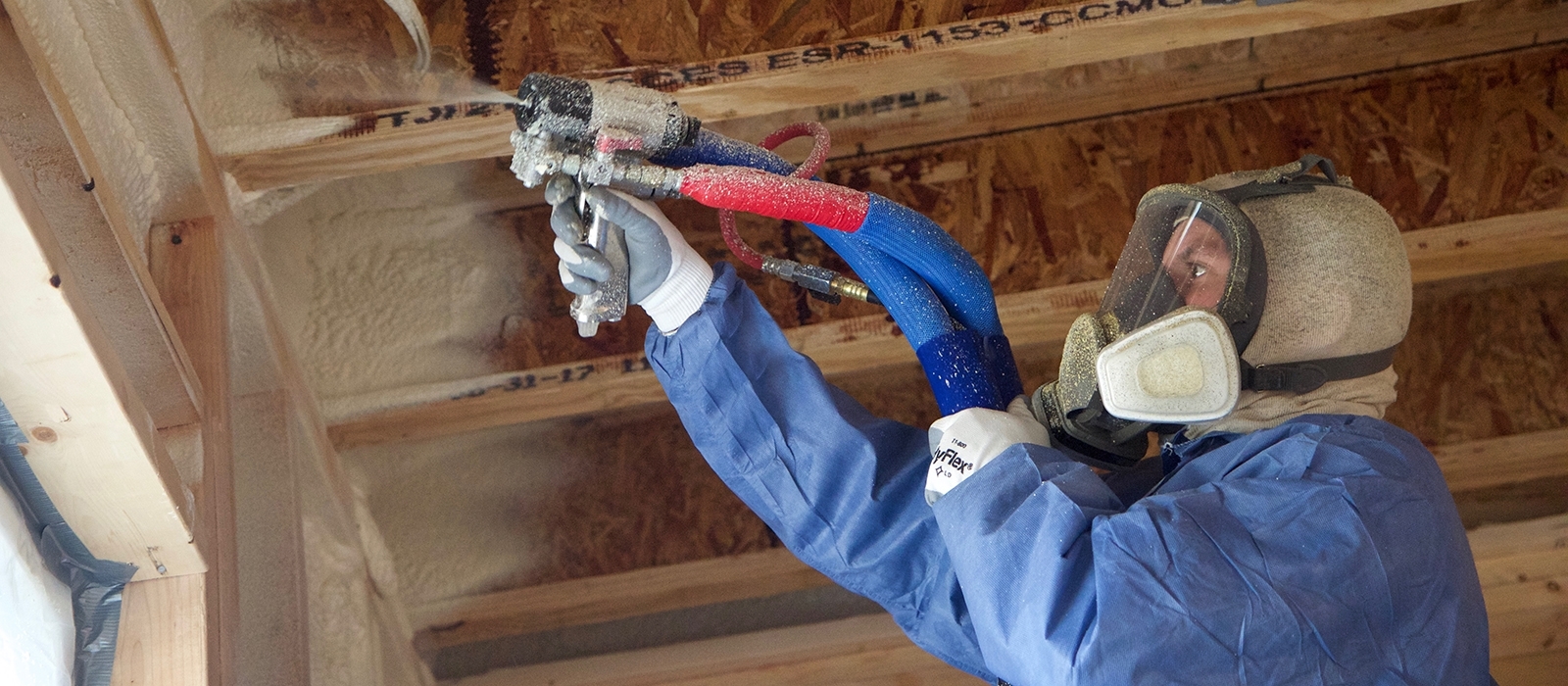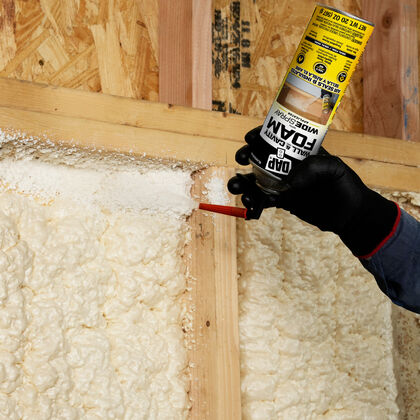Picking the Right Sort Of Spray Foam for Your Insulation Needs
Picking the Right Sort Of Spray Foam for Your Insulation Needs
Blog Article
Spray Foam: The Ultimate Service for Air Sealing and Insulation
Spray foam insulation has actually emerged as a leading service for efficient air sealing and thermal insulation, using an one-of-a-kind combination of residential properties that establish it besides conventional techniques. Its ability to increase and fill spaces makes it especially efficient in protecting against air leakage, which can considerably affect energy performance. Nonetheless, understanding the complete range of its benefits, installment procedures, and contrasts with various other insulation types is crucial for making informed choices. As we discover these elements, the effects for both new building and constructions and retrofits become increasingly considerable. What elements should affect your choice?
What Is Spray Foam?
Spray foam is a flexible insulation product that incorporates the concepts of air sealing and thermal resistance to boost energy efficiency in buildings. Composed largely of polyurethane or various other comparable substances, spray foam is applied as a fluid that increases upon call with surface areas, creating a strong, continuous layer of insulation. This unique residential property enables it to fill voids, fractures, and gaps that typical insulation materials might overlook, supplying a superior air seal.
There are 2 primary kinds of spray foam: open-cell and closed-cell. Open-cell spray foam is lighter and extra versatile, supplying outstanding audio absorption and a lower R-value per inch - Spray Foam. In contrast, closed-cell spray foam is denser, supplying a greater R-value, moisture resistance, and included architectural integrity to building elements
The application process commonly includes specific devices, making certain a seamless application that sticks to different substrates, consisting of steel, concrete, and timber. This flexibility makes spray foam appropriate for both brand-new buildings and retrofitting existing structures. Its ability to develop an impermeable barrier significantly adds to lowering power usage and boosting indoor air high quality, thus making it a recommended selection amongst builders and house owners alike.
Benefits of Spray Foam Insulation
Among one of the most considerable advantages of spray foam insulation is its outstanding ability to produce a continual air obstacle, which successfully decreases energy loss. Unlike typical insulation materials, spray foam broadens to fill fractures and gaps, making sure that air leakage is significantly minimized. This characteristic not only improves energy performance yet likewise results in reduce energy bills gradually.
Additionally, spray foam insulation provides superior thermal resistance, adding to an extra secure interior environment. Its high R-value per inch allows for reliable insulation in confined spaces, making it perfect for attics, walls, and crawl areas. Moreover, the moisture-resistant properties of spray foam aid protect against mold and mildew and mildew growth, advertising much healthier living conditions.
Another essential benefit of spray foam insulation is its sound-dampening high qualities (Spray Foam). It successfully decreases noise transmission in between areas, producing a quieter and a lot more comfortable home setting. The toughness of spray foam additionally stands apart, as it does not sag or work out with time, keeping its performance throughout its life expectancy
How Spray Foam Works
Recognizing just how spray foam insulation functions is necessary for valuing its effectiveness in air securing and thermal resistance. Spray foam insulation is composed of two main elements: isocyanate and polyol resin. When these parts are combined, they go through a chain reaction that causes the product to broaden quickly, creating a thick foam that fills cracks, tooth cavities, and gaps.
As the foam broadens, it follows surfaces, creating an airtight seal that dramatically decreases air infiltration. This characteristic makes spray foam insulation very effective at avoiding drafts and dampness infiltration, which can result in energy loss and damages with time. Furthermore, the closed-cell variation of spray foam offers premium thermal resistance because additional resources of its rigid structure, properly minimizing warm transfer.
The one-of-a-kind residential or commercial properties of spray foam enable it to comply with uneven surfaces, making sure thorough insurance coverage and a smooth obstacle. Therefore, spray foam insulation not only boosts power performance however also adds to improved interior air high quality by minimizing the buildup of irritants and pollutants. Eventually, understanding the auto mechanics behind spray foam underscores its role as an exceptional choice for insulation and air securing in both commercial and property applications.
Setup Process Summary

Prior to setup, the area must be effectively cleaned and prepped, making certain that surfaces are devoid of particles, wetness, and dirt. This step is critical due to the fact that contaminants can endanger attachment and overall performance. As soon as the area is prepared, the application includes blending both elements of the spray foam, which expands upon call and loads gaps efficiently.
Educated professionals need to carry out the setup, using specific devices to ensure consistent insurance coverage and optimum thickness. Safety precautions, including wearing protective equipment and guaranteeing appropriate ventilation, are vital during this process. After application, the foam normally cures rapidly, developing a solid obstacle that enhances energy efficiency.
Contrasting Spray Foam to Standard Insulation
When assessing insulation choices, spray foam insulation stands out in contrast to traditional products such as fiberglass and cellulose. Unlike fiberglass and cellulose, which can permit air infiltration, spray foam broadens upon application, loading holes and voids to develop a closed seal.
Furthermore, spray foam supplies a higher R-value per inch than conventional insulation types, providing even more effective thermal resistance in a thinner account. This particular is especially valuable precede with limited cavity depth. In addition, spray foam is immune to dampness and mold and mildew development, which can be a considerable interest in cellulose and fiberglass, especially in damp atmospheres.
Nonetheless, spray foam insulation usually carries a greater ahead of time price than its conventional equivalents. House owners have to weigh this initial investment versus long-lasting power cost savings and efficiency advantages. Ultimately, while both insulation kinds offer their function, spray foam becomes an advanced option for modern insulation requirements, especially in regards to air sealing and thermal effectiveness.

Verdict
In recap, spray foam insulation stands for a highly reliable solution for accomplishing optimal air sealing and thermal resistance. Its check my site one-of-a-kind residential properties, consisting of wetness resistance and audio dampening, make it ideal for different applications in both brand-new buildings and retrofitting tasks (Spray Foam). The first expenses might be greater contrasted to standard insulation materials, the long-lasting look at more info advantages, such as significant power cost savings and enhanced interior air high quality, warrant the financial investment and highlight its worth in modern-day building techniques.
Spray foam insulation has actually emerged as a leading option for efficient air securing and thermal insulation, providing a distinct mix of residential properties that set it apart from traditional techniques.Spray foam is a functional insulation material that incorporates the principles of air securing and thermal resistance to enhance energy effectiveness in buildings.When examining insulation choices, spray foam insulation stands out in comparison to conventional materials such as fiberglass and cellulose. Ultimately, while both insulation kinds offer their objective, spray foam emerges as an extra innovative solution for modern insulation requirements, especially in terms of air securing and thermal performance.
In recap, spray foam insulation represents an extremely efficient service for accomplishing optimum air securing and thermal resistance.
Report this page